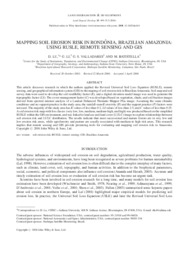Mapping soil erosion risk in Rondônia, Brazilian Amazonia: using rusle, remote sensing and GIS.
Mapping soil erosion risk in Rondônia, Brazilian Amazonia: using rusle, remote sensing and GIS.
Autoria: LU, D.; LI, G.; VALLADARES, G. S.; BATISTELLA, M.
Resumo: This article discusses research in which the authors applied the Revised Universal Soil Loss Equation (RUSLE), remote sensing, and geographical information system (GIS) to the maping of soil erosion risk in Brazilian Amazonia. Soil map and soil survey data were used to develop the soil erodibility factor (K), and a digital elevation model image was used to generate the topographic factor (LS). The cover-management factor (C) was developed based on vegetation, shade, and soil fraction images derived from spectral mixture analysis of a Landsat Enhanced Thematic Mapper Plus image. Assuming the same climatic conditions and no support practice in the study area, the rainfall?runoff erosivity (R) and the support practice (P) factors were not used. The majority of the study area has K values of less than 0.2, LS values of less than 2.5, and C values of less than 0.25. A soil erosion risk map with five classes (very low, low, medium, medium-high, and high) was produced based on the simplified RUSLE within the GIS environment, and was linked to land use and land cover (LULC) image to explore relationships between soil erosion risk and LULC distribution. The results indicate that most successional and mature forests are in very low and low erosion risk areas, while agroforestry and pasture are usually associated with medium to high risk areas. This research implies that remote sensing and GIS provide promising tools for evaluating and mapping soil erosion risk in Amazonia.
Ano de publicação: 2004
Tipo de publicação: Artigo de periódico
Unidade: Embrapa Territorial
Palavras-chave: Brazilian Amazonia, GIS, RUSLE, Remote sensing, Soil erosion risk
Observações
1 - Por padrão são exibidas publicações dos últimos 20 anos. Para encontrar publicações mais antigas, configure o filtro ano de publicação, colocando o ano a partir do qual você deseja encontrar publicações. O filtro está na coluna da esquerda na busca acima.
2 - Para ler algumas publicações da Embrapa (apenas as que estão em formato ePub), é necessário ter, no celular ou computador, um desses softwares gratuitos. Sistemas Android: Google Play Livros; IOS: iBooks; Windows e Linux: software Calibre.
Acesse outras publicações
Acesse a Base de Dados da Pesquisa Agropecuária (BDPA) para consultar o acervo completo das bibliotecas da Embrapa.

